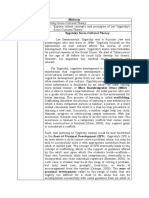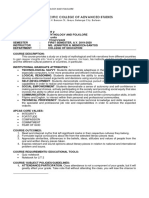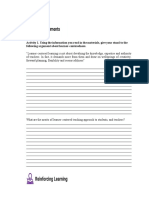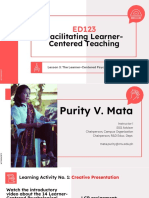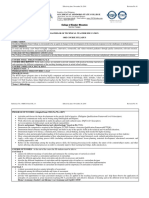Lesson 1: Teaching Listening: Time Frame: 9 Hours
Uploaded by
maryrose condesLesson 1: Teaching Listening: Time Frame: 9 Hours
Uploaded by
maryrose condesLesson 1: Teaching Listening
Lesson 1:
TEACHING LISTENING
INTRODUCTION
Did you know that ………….
your fastest means of communication is listening?
you get more than 40 percent of your information through listening?
you receive messages from any direction, from around corners, and through
some barriers?
Listening plays an active part in our everyday experience. For most of us, we
spend a large part of of our waking hours listening with varying degrees of attention to
language and other stimuli.
Listening is considered as a gateway to understanding and communicating, and
is therefore, absolutely critical for all language learners to develop. Despite the
importance of listening in our daily lives, it is not given the attention it deserves in the
classroom. Among the macro skills in communication, listening is the most neglected
skill as many people assume that listening skills will just develop as a matter of course.
As a consequence, students are not trained to listen attentively and critically. The
inability to listen proficiently can lead to communication breakdown in oral interaction.
In some cases, miscommunication leads to other serious problems because of failure to
listen critically.
It is, thus, necessary that listening skills be taught to prepare students for
effective functioning outside the classroom. As future teachers, it is but crucial that you
understand the importance of developing this skill to help your students become
effective communicators.
Time Frame: 9 hours
Module in TECELA: Teaching English in the Elementary Grades (Language Arts) 8
Lesson 1: Teaching Listening
Objectives
At the end of this lesson, you should be able to:
explain the importance of developing listening and attention skills in
children;
differentiate the types of listening;
prepare varied listening activities for listening comprehension.
Engage L1
Here are some classroom activities. Decide which are entirely listening activities and
which involve an element of listening. Write PL in the box for pure listening activity
and EL if the activity only contains an element of listening
a. Learners respond orally to a written exercise.
b. Learners complete a task while listening to a taped conversation.
c. The teacher explains some special arrangement for the following
week’s lesson.
d. A learner asks the teacher question about the meaning of a word.
e. The teacher conducts a drill with the class.
f. A learner formulates a sentence silently before uttering it.
g. Two learners carry out a pair work activity.
h. The teacher tells a story.
i. The teacher converses with the class before the lesson starts.
j. The class is engaged in a pronunciation exercise focusing on two
constrasting sounds.
Module in TECELA: Teaching English in the Elementary Grades (Language Arts) 9
Lesson 1: Teaching Listening
Self –Check Questions
How well did you do in the activity? Were you able to correctly identify
the activities that employ pure listening activity and those requiring some
degree of listening in order to accomplish the task?
Explore L1
What follows is a checklist of listening activities. Identify the type of listening
required for each activity by checking under the appropriate column.
Activity Type of Listening
Marginal Attentive Critical Appreciative
1. Paying attention selectively and
constantly varying the level of
attentiion while engaged in
other tasks simultaneously
2. Making judgments about which
content to select for
remembering
3. Interpreting implied information,
attitude and intention
4. Filtering out any other ambient
language or other READ
sounds, but
remaining prepared to filter
them in again as and when
WHATnecessary
IS LISTENING?
5. Getting the gist of the talk
Listening is a form of communication and is an active process that requires the
6. Enjoying the music played over
listener to without
the radio get theunderstanding
meaning of what is being said by someone in order to respond
effectively.
the words Cameron (2001) states that listening is the receptive use of language and
7.
thePerforming
focus is onactions in response
meaning rather than language since the primary goal is to make sense of
to instruction given orally
theInterpreting
8. speech. Itmusic
involves
throughthe active selection and interpretation of information coming
from auditory clues so that a listener can identify what is happening and what is being
dance
9. Discussing(Richards,
expressed a problem 1983).
that is
described orally and writing
down a suggested solution
10. Identifying a general topic or
information given in a listening
text
Module in TECELA: Teaching English in the Elementary Grades (Language Arts) 10
Lesson 1: Teaching Listening
Explain L1
WHY LISTEN?
There are varied reasons why people listen. Here are five reasons for listening.
1. To be able to engage in social rituals
As a social being, man usually engages in social rituals such as exchanging
pleasantries, engaging in small talk, attending meeting, and the like.
2. To get information
In school, students have to listen attentively to get important ideas from a
lecture or from class discussions.
3. To be able to respond to controls
There is a need for attentive lstening to be able to follow directions and
instructions given orally.
4. To respond to feelings
It is necessary to listen with empathy to understand what a person means and
how he or she feels. This occurs when one listens to complaints or secrets.
5. To enjoy
Listening enables us to share a good laugh with others as when we exchange
jokes. It could also serve as a source of pleasure when we listen to music and
oral interpretations of literary pieces.
HOW PEOPLE LISTEN?
Listening can be classified into several types depending on how you pay
attention to what is being heard or said.
Marginal/passive listening – Also called hearing or auding, the listener hears the
sounds, often in the background but simply ignores them because he or she is
engrossed in another task.
Attentive listening – The listener focuses attention and shows interest in what is
being said. He or she takes note of the specifics and how they relate to the main
points made by the speaker.
Critical/analytical listening – In this type of listening, one has to decide on the
truth of ideas, pass judgment on claims made and make decisions on whether to
accept what she or he hears, reject it or take it with a grain of salt.
Appreciative listening – In this type of listening behavior, the listener seeks
certain information which he or she will appreciate and meet his/her needs and
Module in TECELA: Teaching English in the Elementary Grades (Language Arts) 11
Lesson 1: Teaching Listening
goals. You use your appreciative listening when you listen to music, poetry, or
stirring words of a speech.
IMPORTANCE OF DEVELOPING LISTENING AND ATTENTION SKILLS
Listening and attention skills are essential skills in a child’s development as they
serve as vital tools in helping the child to function properly in society. To develop these
skills among children, it is important that teachers assist the child to become an active
listener. Children have to be taught how to use what he or she hears from the teacher
and others as part of the communication process. By setting a good example and
working with the students to develop these skills, you as a prospective teacher, can give
him academic and social advantage in the future.
What then are the academic and social advantages of listening and attention
skills? The following are advanced by the Ministry of Education of Guyana.
1. Improves Language and Communication
Children are able to retain information through their interactions with other
people and this includes language skills. The more they are exposed to listening to
people, the more opportunities they have in improving their vocabulary and
communication skills. By developing their listening and attention skills, the more they
gain proficiency in their communication skills as listening and learning go hand in hand.
2. Develops Literacy and Comprehension
As the child develops, he or she will begin to use one’s listening skills to improve
vocabulary, grammar, and reading ability. If the child has not developed his/her
listening skills or does not pay attention, the child might struggle to pick up on mistakes
that one is making with his/her speech due to failure to hear what others have to say.
Reading skills may also be affected if the child has inadequate listening skills since the
child might not pay attention to the words when someone else is reading to him/her.
3. Aids Social Development
When the child starts school, his/her listening skills and attention span increase
in importance. At this age, the child will begin interacting with other children regularly
and will have to retain information based on these interactions. The child’s self-concept
and social life are dependent on his/her interactions with the peers, teachers, and other
members of the school community.
Given the importance of listening skills in the development of a child to become
functional in society, it is important that teachers in the elementary level are
Module in TECELA: Teaching English in the Elementary Grades (Language Arts) 12
Lesson 1: Teaching Listening
knowledgeable of the kind of listening texts to use as well as the techniques to employ
to develop the listening skills.
In choosing the listening text, it is best to select authentic texts that students are
expected to meet and listen to in real life. You can record excerpts of the following
texts or read them aloud at normal speed: advertisements, newscasts, weather reports,
announcements, homilies, doctor-patient consultations, job interviews, etc. Here are
some questions to consider in choosing listening texts.
1. What type of talk is it?
2. Where do you expect to hear it?
3. Who is talking and to whom is he talking?
4. What is the objective of the speaker?
5. What type of listening is called for in the situation?
INTEGRATING LISTENING WITH OTHER MACRO SKILLS
Most listening activities entail the use of other macro-language skills, namely:
speaking, reading, viewing, and writing. In this listening activity (Taking Note of House
Rules), the students listen to a taped dialog, but they are also asked to picture study
(reading), mark with an X the infringement of the rules (writing) and draw the same
scene without the violation of those rules. Note that the task in the Pre-listening phase,
if done orally will entail speaking skills.
Example:
Taking Note of House Rules
Module in TECELA: Teaching English in the Elementary Grades (Language Arts) 13
Lesson 1: Teaching Listening
Pre-listening
Look at the picture on page 13.. That is the bedroom of a new boarder. Do you
think you can identify the things that are not in their proper places?
While listening
Judy is a new boarder in the apartment of Aling Luz. Aling Luz is very selective of
her boarders because her apartment is new.
Listen carefully to the house rules given by Aling Luz. Judy must understand the
rules so she can stay in that apartment.
Can you identify the rules which have not been followed? Put an X inside the
box of the the dialogue to show each rule that was broken.
Audio Recorded Script (If audio recording is not available, the script can just be read by
the teacher.)
The New Boarder
Judy is the new boarder of Aling Luz, a very meticulous land lady. Judy’s room is on the
second floor of a new apartment building.
Judy : Well, it’s a lovely room. Its size is just right for me.
Aling Luz : Oh, yes. It’s a good-sized room and it is well-furnished.
Judy : Yes, I can see that. Is there anything I should know?
Aling Luz : Well, I don’t allow the cat to go upstairs at all.
Judy : Oh. Not at all?
Aling Luz : Absolutely not. I don’t like cats upstairs. And don’t allow people to smoke
in the bedroom.
Judy : That’s okay with me. I don’t smoke anyway.
Aling Luz : I don’t allow people to stick up pictures on the wall with tape. You see,
when you take the pictures down, the tape leaves marks on the wall.
Judy : Oh, I see. Can I use thumb tacks instead?
Aling Luz : Oh yes. Something likke that. But do not use big nails. They leave holes on
the wall. Then, if you go out, please remember to close the window.
Judy : Right! I’ll do that.
Aling Luz : And there’s a kettle for you to boil water in. Place it on the floor and not
on the chest of drawers or cabinet.
Judy : I know. It will leave a mark, especially if it is hot. Is there anything else?
Aling Luz : One last thing – please keep your room tidy. Hang your clothes and see to
it that your books and papers should be on the table or shelf.
Judy : All right, Aling Luz. I’ll try to remember all that you told me.
Module in TECELA: Teaching English in the Elementary Grades (Language Arts) 14
Lesson 1: Teaching Listening
The TLQR Technique (Jocson, 1999)
This is a listening technique that involves 4 steps: Tuning in, Generating Questions,
Listening to the text, and Responding to what is heard.
Here is a sample of how this technique is applied using the given text entitled
“The Pains of Anger”.
The Pains of Anger
Anger causes pain. It is usually expressed in hurting comments, cutting remarks, and sharp retorts. Many
have been wounded by words or actions that have sprung from a heart filled with wrath. But the greatest
pain is felt by the one who is overcome with anger.
One day as Leonardo da Vinci was painting “The Last Supper”, he became mad with a certain man. His
temper flared and he lashed at him with stinging words. Resuming his work, he began to brush some
delicate lines on the face of Jesus. But he was so upset that he could not continue.
He laid down his tools and went to look for the man to ask for forgiveness. Only after he apologized could
Leonardo go back and complete the face of Christ.
Like da Vinci, we are sometimes prevented from doing work effectively because of unresolved anger. We
can overcome it by being reconciled to the one we have offended. His forgiveness will heal and relieve us
from the pains of anger.
1. Tuning In
In this phase, the teacher measures understanding of the main theme by asking
the students to give words that they can associate with the word “ANGER”. Using a
graphic organizer, the teacher lets the class give words related to the key word.
The teacher says: “You are going to listen to a passage entitled “The Pain of
Anger”. What words can you think of in relation to anger?
death
quarrel remorse
ANGER
hatred
sorrow
jealousy
Module in TECELA: Teaching English in the Elementary Grades (Language Arts) 15
Lesson 1: Teaching Listening
2. Generating Questions
What questions come to your mind as you read the title?
The following are possible questions to ask:
How does anger cause pain?
Who will feel the pain more, the angry person or the person he is angry with?
Is it just physical pain? Why or why not?
Do you think this is true in real life?
Can something be done about it?
3. Listening to the text
As the students listen, ask them to check the questions that are answered. It
might be pointed out that all of the raised questions were answered in the text;
although, some of them the answers will have to be inferred.
4. Responding to what is heard
Ask the students to give their answers to the questions raised if these may be
deduced from the text. Here are the responses to the questions cited earlier.
It upsets you.
The person who is angry.
No, it is mental and emotional as well.
Yes, it is, as shown in the incident about da Vinci.
Yes, something can be done about it. The angry person can reach out to the
person he is angry with.
Elaborate L1
Perform the listening activity (The New Boarder) by requesting someone to read the
dialogue to you while you are looking at the picture. Then perform the following:
Activity 1: After listening to the dialogue, write down all the rules which were
broken by Judy in A4 sized bond paper.
Activity 2: If Judy was an obedient boarder and strictly followed the house rules,
how would her room look like? Draw the room based on the expectations of Aling
Luz in A4 sized bond paper.
Activity 3: Based on this activity, what type of listening is required? Why do you
think it is important for a person to develop one’s listening and attention skills?
Module in TECELA: Teaching English in the Elementary Grades (Language Arts) 16
Lesson 1: Teaching Listening
Evaluate L1
Answer the following questions as best as you can. Use A4 bond paper. Write your name,
Year and Section, name of the subject and date of submission.
1. As a future elementary teacher, why is it crucial for you to give importance to the
development of the listening skills of your students? Use examples to justify your point.
(10 pts.)
2. Among the types of listening, attentive and critical listening are deemed essential to
successfully accomplish academic tasks. What strategies may be employed by the
teacher to develop each type of listening (attentive and critical listening)? Cite one
strategy/activity for each and describe how this can be done. (10 pts for each strategy)
Rubric for Rating question #1
The question was . The question was The question was partly The question was not
answered very answered satisfactorily answered. Language correctly answered.
satisfctorily with with relevant examples. used has significant
relevant examples. Language used has errors in grammar and
Language used has no or significant errors in writing mechanics but
minimal errors in grammar and writing the thought is still
grammar and mechanics but the understandable
mechanics in writing. thought is still
understandable.
10-8 pts 7-5 0
4-1
Rubric for Rating question #2
The identified strategy is The identified strategy is The identified strategy The identified strategy
appropriate to address appropriate to address is appropriate to is not appropriate to
the problem. The the problem. The address the problem. develop the type of
procedure given is clear procedure given lacks The procedure given is listening skill.
and detailed. Use of some details. There are not clear and contains
language is free from some errors in grammar significant errors in
errors in grammar and and writing mechanics. grammar and writing
mechanics in writing. mechanics that affect
intelligibility.
10-8 pts 7-5 4-1 0
Module in TECELA: Teaching English in the Elementary Grades (Language Arts) 17
Lesson 1: Teaching Listening
Assignment
There are a lot more listening activities that a teacher may employ in
his/her class. Search the internet and look for at least 3 fun and engaging activities
that can help improve listening skills. Use the format below. Encode or write your
activities in A4-sized bond paper.
Activities to Improve Listening Skills
By: _______________________
Title:
Description:
Source:
Grade Level Intended:
Procedure:
Rubric for Rating the assignment
Relevance Very high High Moderate Low Very low
and
practicality 5 pts 4 pts 3 pts 2 pts 1 pt
Completeness 100 % 90% 80% 70% 60%-below
of data 5 pts 4 pts 3 pts 2 pts 1 pt
Punctuality Submitted on Submitted Submitted Submitted Submitted
or before on Sept. 7, on Sept. 8, on Sept. 9, on Sept.
Sept. 4, 2020 2020 2020 2020 10, 2020
5 pts 4 pts 3 pts 2 pts 1 pt
Equivalent:
15 – 100 12 – 90 9 - 80 6 - 73 3 - 69
14 – 97 11 - 87 8 - 77 5 - 72 2 - 68
13 – 93 10 – 83 7 - 74 4 - 70 1 - 66
Module in TECELA: Teaching English in the Elementary Grades (Language Arts) 18
You might also like
- The Art of Problem Solving Intermediate Algebra96% (25)The Art of Problem Solving Intermediate Algebra720 pages
- Beginner's Step-By-Step Coding Course Learn Computer Programming The Easy Way, UK Edition98% (46)Beginner's Step-By-Step Coding Course Learn Computer Programming The Easy Way, UK Edition360 pages
- The Motivational Interviewing Workbook - Exercises To Decide What You Want and How To Get There100% (10)The Motivational Interviewing Workbook - Exercises To Decide What You Want and How To Get There224 pages
- The End of Composition Studies 1st Edition Professor David W Smit - The full ebook with all chapters is available for download now100% (3)The End of Composition Studies 1st Edition Professor David W Smit - The full ebook with all chapters is available for download now47 pages
- Golf Strategies - Dave Pelz's Short Game Bible PDF92% (24)Golf Strategies - Dave Pelz's Short Game Bible PDF444 pages
- Catherine V Holmes - How To Draw Cool Stuff, A Drawing Guide For Teachers and Students97% (35)Catherine V Holmes - How To Draw Cool Stuff, A Drawing Guide For Teachers and Students260 pages
- SIRI Assessor Training Course Booklet - BSI100% (1)SIRI Assessor Training Course Booklet - BSI14 pages
- [Algebra Essentials Practice Workbook with Answers Linear and Quadratic Equations Cross Multiplying and Systems of Equations Improve your Math Fluency Series] Chris McMullen - Algebra Essentials Practice Workbook with A.pdf80% (10)[Algebra Essentials Practice Workbook with Answers Linear and Quadratic Equations Cross Multiplying and Systems of Equations Improve your Math Fluency Series] Chris McMullen - Algebra Essentials Practice Workbook with A.pdf207 pages
- Math 87 Mathematics 8 - 7 Textbook An Incremental Development Stephen Hake John Saxon100% (10)Math 87 Mathematics 8 - 7 Textbook An Incremental Development Stephen Hake John Saxon696 pages
- Self-System Therapy For Depression Client Workbook100% (8)Self-System Therapy For Depression Client Workbook113 pages
- Chris McMullen - Intermediate Algebra Skills Practice Workbook With Answers - Functions, Radicals, Polynomials, Conics, Systems, Inequalities, and (2021, Zishka Publishing) - Libgen - Li100% (3)Chris McMullen - Intermediate Algebra Skills Practice Workbook With Answers - Functions, Radicals, Polynomials, Conics, Systems, Inequalities, and (2021, Zishka Publishing) - Libgen - Li502 pages
- Lesson 2: Teaching Speaking: ObjectivesNo ratings yetLesson 2: Teaching Speaking: Objectives11 pages
- Facilitating Learner Centered Teaching MidtermNo ratings yetFacilitating Learner Centered Teaching Midterm18 pages
- Gordon College: College of Education, Arts and SciencesNo ratings yetGordon College: College of Education, Arts and Sciences7 pages
- PE 3 - The Teacher and The Community, School Culture and Organizational Leadership100% (1)PE 3 - The Teacher and The Community, School Culture and Organizational Leadership141 pages
- Course No.: Ed 105 Descriptive Title: Facilitating Learning: CHAPTER I - MetacognitionNo ratings yetCourse No.: Ed 105 Descriptive Title: Facilitating Learning: CHAPTER I - Metacognition17 pages
- Approaches, Strategies & Methods of TeachingNo ratings yetApproaches, Strategies & Methods of Teaching4 pages
- Microsoft Word 2010 Easter Egg Hunt Flyer TutorialNo ratings yetMicrosoft Word 2010 Easter Egg Hunt Flyer Tutorial33 pages
- Learner-Centered Psychological Principles (LCP)No ratings yetLearner-Centered Psychological Principles (LCP)24 pages
- Week 6: Ms. Thelma G. Baloran, Maed InstructorNo ratings yetWeek 6: Ms. Thelma G. Baloran, Maed Instructor8 pages
- SEM 111 Weeks13-14 Language Learning Material Development (20230426095827)No ratings yetSEM 111 Weeks13-14 Language Learning Material Development (20230426095827)17 pages
- Lecture Guide Remedial Instruction in English 1100% (1)Lecture Guide Remedial Instruction in English 122 pages
- Communication Processes Principles and Ethics100% (1)Communication Processes Principles and Ethics41 pages
- Section 1.the Professional Teachers Are Socially Responsible Chapter 1. Socially Responsible Teachers: Rich With Professional HeritageNo ratings yetSection 1.the Professional Teachers Are Socially Responsible Chapter 1. Socially Responsible Teachers: Rich With Professional Heritage5 pages
- GROUP 2 The Structure of The K To 12 Language Arts Curriculum 2100% (1)GROUP 2 The Structure of The K To 12 Language Arts Curriculum 225 pages
- Students Who Are Blind or Have Low VisionNo ratings yetStudents Who Are Blind or Have Low Vision26 pages
- Activity 1. Using The Information You Read in The Materials, Give Your Stand To The Following Argument About Learner-CenterednessNo ratings yetActivity 1. Using The Information You Read in The Materials, Give Your Stand To The Following Argument About Learner-Centeredness6 pages
- Introduction To Curriculum Development Lesson 1No ratings yetIntroduction To Curriculum Development Lesson 188 pages
- Strategies For Facilitating Learning inNo ratings yetStrategies For Facilitating Learning in46 pages
- Seminar On Integrative Paper and Dissertation WritingNo ratings yetSeminar On Integrative Paper and Dissertation Writing31 pages
- Lesson 3 The Learner-Centered Psychological PrinciplesNo ratings yetLesson 3 The Learner-Centered Psychological Principles21 pages
- Introduction To Effective Oral CommunicationNo ratings yetIntroduction To Effective Oral Communication30 pages
- Lesson 1 Listening Teaching English in The Elementary Grade Language ArtsNo ratings yetLesson 1 Listening Teaching English in The Elementary Grade Language Arts22 pages
- Agusan Del Sur State College of Agriculture and TechnologyNo ratings yetAgusan Del Sur State College of Agriculture and Technology13 pages
- "Syntax and Semantics": Capalonga College IncNo ratings yet"Syntax and Semantics": Capalonga College Inc14 pages
- Lesson 5: Teaching Viewing: Time Frame: One Week 9 Hours100% (4)Lesson 5: Teaching Viewing: Time Frame: One Week 9 Hours13 pages
- Alijis Campus - Binalbagan Campus - Fortune Towne Campus - Talisay Campus100% (1)Alijis Campus - Binalbagan Campus - Fortune Towne Campus - Talisay Campus8 pages
- Florida Teacher Certificate Examinations (FTCE) Study Guide0% (2)Florida Teacher Certificate Examinations (FTCE) Study Guide20 pages
- 'The Appraisal Model of Coping: Assessment and Intervention Model For Occupational 'TherapyNo ratings yet'The Appraisal Model of Coping: Assessment and Intervention Model For Occupational 'Therapy10 pages
- Bharathidasan University Tiruchirappalli - 620 024 Centre For Distance EducationNo ratings yetBharathidasan University Tiruchirappalli - 620 024 Centre For Distance Education156 pages
- HC Verma Solutions Class 11 Chapter 2 - Physics and MathematicsNo ratings yetHC Verma Solutions Class 11 Chapter 2 - Physics and Mathematics6 pages
- Notes Class 12 Chemistry Aldehydes Ketones and CarboxylNo ratings yetNotes Class 12 Chemistry Aldehydes Ketones and Carboxyl26 pages
- Physical Education and Health For Grade 11 Daily Activities: Unit Iii: Safety EtiquettesNo ratings yetPhysical Education and Health For Grade 11 Daily Activities: Unit Iii: Safety Etiquettes2 pages
- Sy 2024 2025 Prisab Napsphil Academic CompetitionNo ratings yetSy 2024 2025 Prisab Napsphil Academic Competition7 pages
- Recurrent Thyroglossal Duct Cysts: A 15-Year Review of Presentation, Management and Outcomes From A Tertiary Paediatric InstitutionNo ratings yetRecurrent Thyroglossal Duct Cysts: A 15-Year Review of Presentation, Management and Outcomes From A Tertiary Paediatric Institution6 pages
- The Effect of Community of Practice On Students' Confidence in Public SpeakingNo ratings yetThe Effect of Community of Practice On Students' Confidence in Public Speaking63 pages
- The Intercultural Approach To EFL Teaching and Learning - Doc EFLNo ratings yetThe Intercultural Approach To EFL Teaching and Learning - Doc EFL37 pages
- Beginner's Step-By-Step Coding Course Learn Computer Programming The Easy Way, UK EditionBeginner's Step-By-Step Coding Course Learn Computer Programming The Easy Way, UK Edition
- The Motivational Interviewing Workbook - Exercises To Decide What You Want and How To Get ThereThe Motivational Interviewing Workbook - Exercises To Decide What You Want and How To Get There
- The End of Composition Studies 1st Edition Professor David W Smit - The full ebook with all chapters is available for download nowThe End of Composition Studies 1st Edition Professor David W Smit - The full ebook with all chapters is available for download now
- Golf Strategies - Dave Pelz's Short Game Bible PDFGolf Strategies - Dave Pelz's Short Game Bible PDF
- Catherine V Holmes - How To Draw Cool Stuff, A Drawing Guide For Teachers and StudentsCatherine V Holmes - How To Draw Cool Stuff, A Drawing Guide For Teachers and Students
- [Algebra Essentials Practice Workbook with Answers Linear and Quadratic Equations Cross Multiplying and Systems of Equations Improve your Math Fluency Series] Chris McMullen - Algebra Essentials Practice Workbook with A.pdf[Algebra Essentials Practice Workbook with Answers Linear and Quadratic Equations Cross Multiplying and Systems of Equations Improve your Math Fluency Series] Chris McMullen - Algebra Essentials Practice Workbook with A.pdf
- Math 87 Mathematics 8 - 7 Textbook An Incremental Development Stephen Hake John SaxonMath 87 Mathematics 8 - 7 Textbook An Incremental Development Stephen Hake John Saxon
- Self-System Therapy For Depression Client WorkbookSelf-System Therapy For Depression Client Workbook
- Chris McMullen - Intermediate Algebra Skills Practice Workbook With Answers - Functions, Radicals, Polynomials, Conics, Systems, Inequalities, and (2021, Zishka Publishing) - Libgen - LiChris McMullen - Intermediate Algebra Skills Practice Workbook With Answers - Functions, Radicals, Polynomials, Conics, Systems, Inequalities, and (2021, Zishka Publishing) - Libgen - Li
- Gordon College: College of Education, Arts and SciencesGordon College: College of Education, Arts and Sciences
- PE 3 - The Teacher and The Community, School Culture and Organizational LeadershipPE 3 - The Teacher and The Community, School Culture and Organizational Leadership
- Course No.: Ed 105 Descriptive Title: Facilitating Learning: CHAPTER I - MetacognitionCourse No.: Ed 105 Descriptive Title: Facilitating Learning: CHAPTER I - Metacognition
- Microsoft Word 2010 Easter Egg Hunt Flyer TutorialMicrosoft Word 2010 Easter Egg Hunt Flyer Tutorial
- SEM 111 Weeks13-14 Language Learning Material Development (20230426095827)SEM 111 Weeks13-14 Language Learning Material Development (20230426095827)
- Section 1.the Professional Teachers Are Socially Responsible Chapter 1. Socially Responsible Teachers: Rich With Professional HeritageSection 1.the Professional Teachers Are Socially Responsible Chapter 1. Socially Responsible Teachers: Rich With Professional Heritage
- GROUP 2 The Structure of The K To 12 Language Arts Curriculum 2GROUP 2 The Structure of The K To 12 Language Arts Curriculum 2
- Activity 1. Using The Information You Read in The Materials, Give Your Stand To The Following Argument About Learner-CenterednessActivity 1. Using The Information You Read in The Materials, Give Your Stand To The Following Argument About Learner-Centeredness
- Seminar On Integrative Paper and Dissertation WritingSeminar On Integrative Paper and Dissertation Writing
- Lesson 3 The Learner-Centered Psychological PrinciplesLesson 3 The Learner-Centered Psychological Principles
- Lesson 1 Listening Teaching English in The Elementary Grade Language ArtsLesson 1 Listening Teaching English in The Elementary Grade Language Arts
- Agusan Del Sur State College of Agriculture and TechnologyAgusan Del Sur State College of Agriculture and Technology
- Lesson 5: Teaching Viewing: Time Frame: One Week 9 HoursLesson 5: Teaching Viewing: Time Frame: One Week 9 Hours
- Alijis Campus - Binalbagan Campus - Fortune Towne Campus - Talisay CampusAlijis Campus - Binalbagan Campus - Fortune Towne Campus - Talisay Campus
- Florida Teacher Certificate Examinations (FTCE) Study GuideFlorida Teacher Certificate Examinations (FTCE) Study Guide
- 'The Appraisal Model of Coping: Assessment and Intervention Model For Occupational 'Therapy'The Appraisal Model of Coping: Assessment and Intervention Model For Occupational 'Therapy
- Bharathidasan University Tiruchirappalli - 620 024 Centre For Distance EducationBharathidasan University Tiruchirappalli - 620 024 Centre For Distance Education
- HC Verma Solutions Class 11 Chapter 2 - Physics and MathematicsHC Verma Solutions Class 11 Chapter 2 - Physics and Mathematics
- Notes Class 12 Chemistry Aldehydes Ketones and CarboxylNotes Class 12 Chemistry Aldehydes Ketones and Carboxyl
- Physical Education and Health For Grade 11 Daily Activities: Unit Iii: Safety EtiquettesPhysical Education and Health For Grade 11 Daily Activities: Unit Iii: Safety Etiquettes
- Recurrent Thyroglossal Duct Cysts: A 15-Year Review of Presentation, Management and Outcomes From A Tertiary Paediatric InstitutionRecurrent Thyroglossal Duct Cysts: A 15-Year Review of Presentation, Management and Outcomes From A Tertiary Paediatric Institution
- The Effect of Community of Practice On Students' Confidence in Public SpeakingThe Effect of Community of Practice On Students' Confidence in Public Speaking
- The Intercultural Approach To EFL Teaching and Learning - Doc EFLThe Intercultural Approach To EFL Teaching and Learning - Doc EFL




























